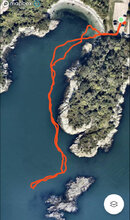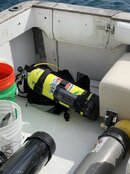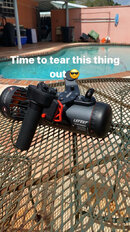Our second dive Sunday was at FTW, Max depth of 40' dive time 35 minutes, visibility 5'-7', water Temp 55F.
My dive buddy, Mike, and I bought a pair LeFeet S1 underwater scooters last winter for a price considerably less than it's list. I won't go into the convoluted story behind the purchase, but I was concerned about spending a significant amount of money on an unproven piece of gear. The S1 is a modular system that allows for a number of different configurations (for additional costs). We each have the basic two handed, single motor variety that has three power settings.
When Mike and I bought them, we had two basic concerns. First, are they practical? A “real” DPV (Diver Propulsion Vehicle) are much larger, has a larger propeller and significantly longer run time. The S1 has an overall length of just over 12”, weighs 4.4 lbs and is said to have a run time of 30 minutes to one hour.
The small size and short run time is probably my biggest concerns for the unit. If it can't pull a diver or only runs for a couple of minutes pulling a fully loaded diver, it is of very limited practicality (at least to me). The specs for most of the unit are easy to check, thrust and run time are the most important and most easily fudged.
The Test
Mike and I decided to make our second dive of the a test run to see how well the S1 would do under real world dive conditions. I am probably the worst case scenario for the Lefeet. I am a 6'7” diver weighing in at 240 lbs. I was diving in a drysuit wearing 40 lbs of lead and a steal 120 cubic foot cylinder. Mike was also diving dry and towing the flag. Except for a couple of brief pulses at high the bulk of the test was done at a medium setting.
We entered the Cove via the boat ramp and headed out along the East wall of the cove to a the big overhanging rock where the USCG had their corrosion test stand a few years ago. Running on medium the entire way, the LeFeet took us at a what would have been a brisk swimming speed all the way out. While I could probably have swum that speed for short distances, I doubt I could have sustained it for any length of time without burning through a considerable amount of air. If I used my fins to assist, I could easily go faster. We hit our maximum depth at that point and turned around for the cruise in. My DPV kept running at medium power for about 23 minutes, before throttling back to low when the battery indicator reached 25% and continued to run for the rest of the dive. Mike's, which had not been on a charger recently, completely stalled out by the end of the dive and he ended up swimming it in the last couple of minutes. Our total distance traveled was around 0.4 miles
At low speed, the machine was still able to deliver a satisfactory amount of thrust to keep a diver moving at a decent, but not impressive, clip. Unless you are just screwing around, I would avoid going beyond medium thrust,. The faster you go through the water, your drag goes up exponentially. My guess is that if a diver was using it only at low speeds, not in a drysuit, you may get quite a bit of range. The good news is that it is not a full sized DPV. When the battery is empty it is small enough that it can be swum in clipped off to your BCD. They are about two pounds negative and will sink if you stop the motor. I did notice while using it maintaining buoyancy was slightly different. Because of the thrust provided, I couldn't judge my trim very well. I was being towed along above the bottom and if I took my finger off the throttle, I immediately settled on the sand. This could be a concern in more environmentally sensitive areas.
A few additional notes about what I do and don't like. It cannot be charged off of your car battery. It needs a real outlet to fully recharge (in about 2.5 hours, according to the manufactured). The throttle control is on a Bluetooth connected handle and has to be charged separately. I think this is great because it avoids the likelihood of a through the hull fitting leaking. The battery is the largest battery that can bee carried legally on an aircraft. I wish they had an option for a battery twice this size, to give it a lot more range and utility. I don't know enough about laws governing shipping equipment through the mail, so this may simply have been a practical limitation of the device. I doubt this is the type of equipment I would drag on dive travel, but I could see them being a popular rental item if they had better range.
Would I take this on a serious tech dive, cave dive? No, probably not. This is gear a recreational diver may use to get somewhat better access to some sites. I wouldn't take it anywhere I wasn't willing to swim back from if the battery died. That said, I am not completely disappointed and am curious to see how it works during the regular wetsuit season.







